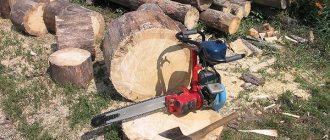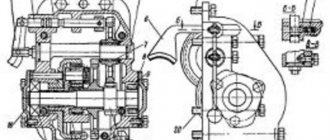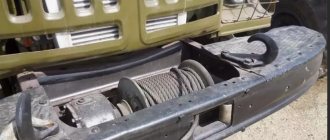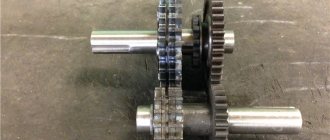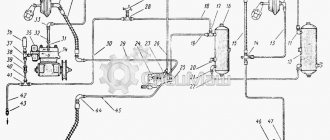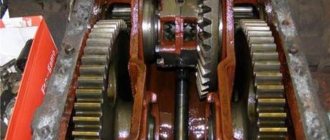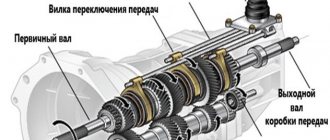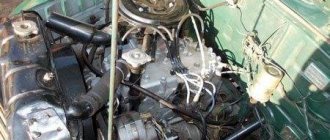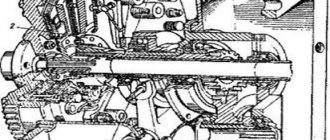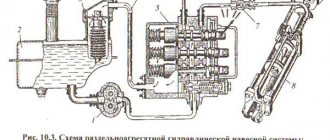What is reverse in a gearbox?
Reverse is a reversing mechanism, made in the form of a device that provides the ability to change the direction of movement to the opposite. ... A gearbox with reverse is equipped with additional drive gears that are responsible for the direction of rotation of the remaining gears of the gearbox.
Interesting materials:
What is data anonymization? What is mandatory product labeling? What is the volume of production? What is cloud data storage and what is it intended for? What is metabolism in biology? What is Overcast Stitch? What is capital turnover? What is store turnover? What is a safety justification for a hazardous production facility? What is a safety case?
Reverse mechanism
In a reverse drive, the clutch is located between bevel gears, which are located on the main shaft. This device has a name: a reversing circuit, which is not at all complicated.
The advantage of this equipment is to reverse, which is often very necessary for the car in various situations. Of course, this system does not provide the possibility of obtaining high speeds, but this is not a big drawback.
So, having examined the types, structure and operating principle of various gearboxes, we come to the conclusion that it is possible to make them yourself at home.
Materials used:
- Small bevel gear Z-16 (1.65/1.85 WIRAX 5036/010660) from a rotary mower Poland. — 2 pieces — 2300 rub.
- Drive shaft of small pulley 5036010260 (2 keys) - 2 pcs - 1000 rub.
- Bearing 180305 - 4 pcs - 600 rub.
- The key is 12*8*50 (mower mouth), but I spread it along the poles, lengthwise - 2 pieces - 100 rubles.
- In total, we get 4,000 rubles worth of materials.
The bearings are pressed onto the shaft, then inserted into the cage, the cage is tightened with clamps as much as possible and then welded so that the metal is pulled in during welding and the bearings are clamped.
The result is this, a homemade bevel gear made with your own hands. Will be installed on a segment mower.
The reverse gearbox is included in the main part of the walk-behind tractor - the drive. The durability of the walk-behind tractor depends on its reliability. The task of such a gearbox is to preserve and maintain the performance of the machine in difficult conditions.
Rice.
1. Reverse gearbox: 1 - reverse shaft; 2 - gear; 3 - drive shaft; 4 — drive gear; 5 — filler neck body; 6 - dipstick; 7 — shift lever; 8 - gear; 9 — driven shaft; 10 — gear; 11 - gear; 12 — reverse shaft gear; 13 — driven gear; 14 - reduced speed shaft The reverse gear unit is shown in Fig. 1. Four shafts are installed in the bores of the cast iron body on bearings: the drive shaft, the driven shaft, the reduced speed shaft and the reverse shaft.
A drive gear is installed on the drive shaft, which can move along the shaft splines and engage with a driven gear mounted motionless on the shaft splines, or with a gear also mounted motionlessly on the shaft splines.
On the same shaft there is a gear fixedly mounted on splines, which is in constant mesh with a gear fixedly mounted on the shaft splines.
The drive shaft has internal splines for the power take-off drive shaft.
A gear is mounted on the shaft; it can move along the splines of the shaft and engage with a gear mounted motionless on the shaft, or using a gear coupling with the shaft.
The moving gears are moved and installed in the desired position using a gear shift mechanism.
When direct transmission is engaged, the driven shaft gear clutch is engaged with the teeth of the drive shaft, and the movement from it is transmitted directly to the driven shaft.
To engage the “Forward” low gear, the gear is engaged with a gear mounted on the shaft, and the gear is engaged with the gear.
To engage the “Back” gear, the gear is brought into engagement with the gear on the shaft, and the transmission will be carried out from shaft to shaft, from the shaft through gears to the shaft and through gears to the shaft.
The gear shift mechanism of the reverse gearbox and the gearbox shift mechanism are fundamentally the same.
Two shift bars are attached to the bottom of the upper cover of the reverse gear using a stamped clip, to which forks are welded. The shift fork of the left bar fits with its horns into the annular groove of gear 8, and the shift fork of the right bar fits into the ring groove of the gear.
The shift bars together with the forks can be moved by a lever and installed in a certain position using spring clamps. To prevent the simultaneous movement of two slats, a dividing strip is installed between them.
The necessary gears of the reverse gearbox are engaged according to the diagram (Fig. 2).
Rice. 2. Reverse gear shift diagram
To prevent spontaneous disengagement of gears, as well as to reduce the end wear of gear teeth when changing gears, the reverse gear is blocked with the gearbox and the main clutch. The locking mechanism consists of two locking rollers, clamps and a locking rod. The locking rollers are connected by a rod to the gearbox locking mechanism, which in turn is connected to the main clutch release mechanism.
When the main clutch is disengaged, both locking rollers are rotated so that their sockets are installed above the clamps and do not interfere with the lifting of the clamps when the bars move at the time of gear shifting of the reverse gearbox.
When the main clutch is engaged, the locking roller sockets are shifted relative to the clamps, so it is impossible to switch the reverse gearbox.
To lubricate the reverse gearbox, transmission oil is used, which is used to lubricate tractor transmission units. Oil is poured into the gear housing through the neck.
The oil level is controlled by a dipstick mounted in the breather plug, with the plug unscrewed. It should be borne in mind that the heating of the oil and parts of the reverse gearbox during tractor operation can reach a temperature of +90 °C at an ambient temperature of +40 °C.
Maintenance of the reverse gearbox consists of timely adding oil and eliminating leaks. After the first 30 hours of tractor operation, it is necessary to drain the oil from the reverse gearbox, rinse the housing with diesel fuel and fill with fresh oil to the top mark of the dipstick.
Check the oil level in the reverse gearbox and add oil within the time limits specified in the maintenance rules.
The control mechanism of the DT-75V tractor with a reverse gear differs from the control mechanism of the DT-75V tractor in the absence of control parts for the torque multiplier.
COMMENTS • 39
So the power supply suddenly began to shift into reverse, in reverse in any gear, I turn on reverse and in reverse, and in forward in any gear it shifts, tractor T 40, what could be the reason?
@Valik D it’s possible and I did it once
And also the food, reverse garna is a thing, but you can weld the reverse clutch until the last hour

